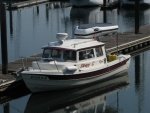As much as we would like to defend friends, or associates we have good times with, in this case, some very serious mistakes were made, and a number of lives lost. A question I pose is which marine professional should be held to a higher standard, or have more training; the master of a 85 foot Dive boat carrying passengers for hire, or the captain of an ocean going tug boat? In reality the master of the dive boat has more responsibility for lives. Yet I believe that the master of an ocean going tug has far more training requirements.
I wonder what "Trained to fight fires" means, in comparison to the codes for training which are required for the International Convention on Training, Certification and Watch keeping for Seafarers – (STCW Convention – and its associated Code). For example the crew of the tug has to take a 4 day fire fighting course every few years. The tug boat should have two persons on watch at all times--even at anchor when on standby duty. Watch does not mean sitting in a chair reading a book, it means roving thru the boat checking all systems and persons on a regular frequent schedule.
I was certified by NAUI in the early to mid 60s by Sam Lecocq and John Cronin was my PADI instructor in the later 60's. I began free diving in 1946; SCUBA was so liberating. I'll admit an aversion to the cattle dive boats. I monitored a abalone bed behind some kelp and under a ledge, at Arrow Point, where I took enough for a meal now and then for years. One day I saw a "dive boat" anchored there after SCUBA came on the scene. I went there next day. There was not one abalone of any size left. I watched that area for many years, and it never recovered as of the late 90's The over harvesting is what killed the abalone population at Catalina. A pink ab at Catalina takes 14 years on an average to reach legal size. The, at one time more common green, takes 14 to 21 years or black can take 20 to 30 years. I mention this because the dive boat operators were more interested in a profit, than protecting the resources.
I was involved with the implication of early diving regulations in S. Calif. At one time I had pronounced dead several teens who had instructions in their high schools, and then were taken by cattle boats to dive Catalina. The crews ( late 1960's to early 70's) were not prepared with a skiff or rescue vessel, underwater recall alarm, proficient dive masters and adequate instruction of the divers. All of these safety features were finally incorporated into the organizations locally and be came the rules in Los Angles County. Death on diving expeditions is very personal with me; I have seen too many accidents. I also have a friend who owns a large dive boat in the LA area, so I understand the the issues involved with crew retention, and the difficulties of of running the business.
When I came to Pensacola, where there is a very active (and close) diving community; their safety features were not up to date. I joined and chaired the Marine Resource committee and was able to implement better safety standards.
Although we would prefer otherwise, bad things can happen very fast on boats at sea--even at anchor. Fire at sea is very high on that list of catastrophies, and there are many factors in preventing it. Unfortunately a vessel passing "Coast Guard Inspection" may not mean state of the art. What was the fire alarm system? Smoke, CO detection, heat detection? How about video surveillance, (very common on yachts these days)? What means of suppression was built into the boat? Sprinkler system, Containment bulkheads, and fire doors? How much instruction was given to the passengers ref fire suppression, escape techniques, and safety precautions? Was there crew members qualified and equipped to go into a room with hot gasses, or a fire to affect rescue? Some of these will come out in the final reports.
The crew members and owner of the operation have to live the rest of their lives with the consequences. There will be potential criminal as well as civil legal proceedings against multiple parties, probably to include the organizers of the trip, although they had no control over the situation.
We should all learn from this tragedy--have adequate fire fighting gear aboard our boats (We have 4 extinguishers, of various types). Have 3 CO detector, and smoke/fire alarms. Do routine inspections of fittings, especially electrical, and fuel lines. Know your escape routes, and have a plan. On our larger boats we had engine room fire suppression systems, a written plan for fire, which every new guest had to read (along with other info). We had several heat detectors, as well as the CO and Smoke detectors. Be safe!


